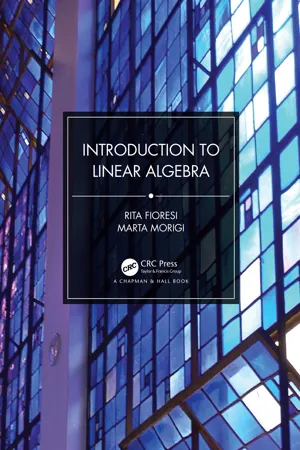
This is a test
- 280 pages
- English
- ePUB (mobile friendly)
- Available on iOS & Android
eBook - ePub
Introduction to Linear Algebra
Book details
Book preview
Table of contents
Citations
About This Book
Linear algebra provides the essential mathematical tools to tackle all the problems in Science. Introduction to Linear Algebra is primarily aimed at students in applied fields (e.g. Computer Science and Engineering), providing them with a concrete, rigorous approach to face and solve various types of problems for the applications of their interest. This book offers a straightforward introduction to linear algebra that requires a minimal mathematical background to read and engage with.
Features
-
- Presented in a brief, informative and engaging style
-
- Suitable for a wide broad range of undergraduates
-
- Contains many worked examples and exercises
Frequently asked questions
At the moment all of our mobile-responsive ePub books are available to download via the app. Most of our PDFs are also available to download and we're working on making the final remaining ones downloadable now. Learn more here.
Both plans give you full access to the library and all of Perlego’s features. The only differences are the price and subscription period: With the annual plan you’ll save around 30% compared to 12 months on the monthly plan.
We are an online textbook subscription service, where you can get access to an entire online library for less than the price of a single book per month. With over 1 million books across 1000+ topics, we’ve got you covered! Learn more here.
Look out for the read-aloud symbol on your next book to see if you can listen to it. The read-aloud tool reads text aloud for you, highlighting the text as it is being read. You can pause it, speed it up and slow it down. Learn more here.
Yes, you can access Introduction to Linear Algebra by Rita Fioresi, Marta Morigi in PDF and/or ePUB format, as well as other popular books in Mathematics & Algebra. We have over one million books available in our catalogue for you to explore.
Information
CHAPTER 1
Introduction to Linear Systems
In this chapter, we discuss how to solve linear systems with real coefficients using a method known as Gaussian algorithm. Later on, we will also use this method to solve other questions; at the same time, we will interpret linear systems as special cases of a much deeper theory.
1.1 LINEAR SYSTEMS: FIRST EXAMPLES
A linear equation is an equation where the unknowns appear with degree 1, that is an equation of the form:
(1.1)
where and b are assigned numbers and are the unknowns. The numbers are called coefficients of the linear equation, b is called known term. If the equation is said to be homogeneous. A solution of the equation (1.1) is a n-tuple of numbers that gives an equality when put in place of the unknowns. For example is a solution of the equation because .
A linear system of m equations in n unknowns is a set of m linear equations in n unknowns that must be simultaneously satisfied:
Table of contents
- Cover
- Half Title
- Title Page
- Copyright Page
- Contents
- Preface
- CHAPTER 1 ▪ Introduction to Linear Systems
- CHAPTER 2 ▪ Vector Spaces
- CHAPTER 3 ▪ Linear Combination and Linear Independence
- CHAPTER 4 ▪ Basis and Dimension
- CHAPTER 5 ▪ Linear Transformations
- CHAPTER 6 ▪ Linear Systems
- CHAPTER 7 ▪ Determinant and Inverse
- CHAPTER 8 ▪ Change of Basis
- CHAPTER 9 ▪ Eigenvalues and Eigenvectors
- CHAPTER 10 ▪ Scalar Products
- CHAPTER 11 ▪ Spectral Theorem
- CHAPTER 12 ▪ Applications of Spectral Theorem and Quadratic Forms
- CHAPTER 13 ▪ Lines and Planes
- CHAPTER 14 ▪ Introduction to Modular Arithmetic
- APPENDIX A ▪ Complex Numbers
- APPENDIX B ▪ Solutions of some suggested exercises
- Bibliography
- Index